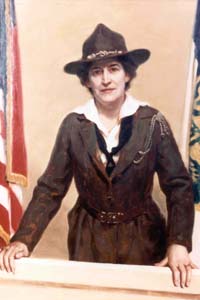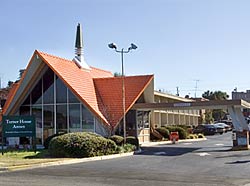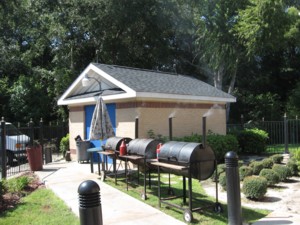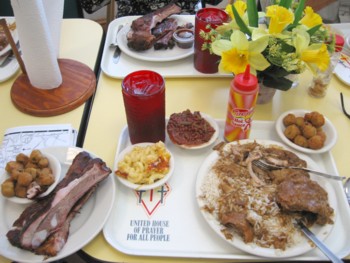
View of Savannah, Georgia, 1734. The hotel we stayed at was on the uncity side of the river, between the trees. (Perry-Castañeda Library Map Collection, University of Texas.)
A Moment in Savannah
William Blake saw the world in a grain of sand, but I saw a slice of Savannah in a grain of rice.
My usual Washington Square is in New York’s Greenwich Village, rescued by angry neighbors from the egomaniacal traffickings of Robert Moses. But this smaller, manicured Washington Square, eerily quiet at dusk, is in lush Savannah, Georgia, and the site of a genial event welcoming the American Association of Sunday and Feature Editors. Savannah’s green and pleasant squares, emeralds in urban settings, define the historical center of the new land’s first planned city.
At one food table, we were offered — with the easy hospitality that turned out to be as common here as moss on live oaks — something chef Christopher Hewitt of the Olde Pink House calls Southern Sushi. The shtick is that rice is replaced by grits. (Which surrounds smoked shrimp salad — plenty of wild Georgia shrimp hereabouts. Then the roll is battered, covered with panko and coconut crumbs, fried, and drizzled with soy reduction and wasabi vinaigrette.)
This struck me as odd. One would have thought that rice was at least as Southern as coarse cornmeal, considering it was Georgia’s first staple crop and the source of Lowcountry fortunes until its farming moved southwest at the 19th century’s end. Has sushi made rice “culturally Japanese”? Polenta hasn’t yet made grits Italian.
The caterer placed small dishes of that grushi upon the shelves of a tall bookcase on the lawn for us to take — a novel, yet strangely disconcerting, way to serve.
Later I read that in Savannah, “rice with fish is unheard of.” Georgia-kosher?

Portrait of Juliette Gordon Low (“Daisy”) by A. Jonnieaux
House Tour
What was that woman doing at our little party dressed in a dun-colored military outfit that looked almost a century old? She chatted away assuming I would know that Girl Scouts founder Juliette Gordon Low — familiarly known as Daisy, a decent painter and sculptor, the woman she was impersonating — was a Savannah notable. The actress obviously loved her city, and if the elaborate costume was an instrument of torture in the steam-bath heat of the evening, she didn’t let on.
She also didn’t mention Daisy’s fateful grain of rice.
A taxi driver previously told one of our group’s editors that if she had one house tour to take, it should be Daisy’s birthplace. So one afternoon we walked to the Victorianized Regency manse at 10 East Oglethorpe Avenue, paid our fee, and got a snappy room-by-room narrative from a guide who turned out to be a journalist herself.
In front of a dingy painting of the somewhat ordinary-looking young woman, we tourists were taken aback by this unexpected detail: At Daisy’s wedding to the well-heeled heel William Mackay Low (“who never worked a day in his life”), a grain of rice tossed at the just-married couple became lodged in the bride’s ear. An English honeymoon was curtailed because her ear became infected, and a doctor back home trying to remove the rice punctured her eardrum. Already deaf in the other ear (another wretched doctor), Daisy completely lost her hearing — and her husband.
After that, the rest of the house, and her inspiring story, were dust.

New Museum
The light that streams into the glass-covered atrium would flatter the faces of any betrothed couple who walked down the broad, party-friendly staircase of Moshe Safdie’s Jepson Center for the Arts, which opened in March 2006.
One could predict a battle to build anything obviously new within this city’s core, and indeed it took years of back-and-forths with the Savannah Historic District Board of Review for the hoary Telfair Museum of Art to get the go-ahead for its contemporary branch. The resulting 64,000-square-foot space, a civic victory, must glow like a beacon of modern refreshment at night. But during the day I’m afraid the white-limestone and cement side walls look makeshift; some of that outdoor limestone, the color of dirty rice, is already cracking.
Local, Local, Local
Two smart friends-of-friends living in Savannah sent us to a polished, too-new-for-guidebooks place in a defunct deco bank, chic as can be. The chef at Local 11 Ten strives to use local ingredients, but without the anchor of local recipes; I am afraid I’m becoming what is known as a “locavore.” With one slight exception, which has to do with geometry and calculus, everything satisfied — the prosciutto-wrapped rabbit especially hopped into our collective maw. Flat, green pole beans that accompanied the “100-mile” flounder entrée (one 100-miler is offered daily, cooked from ingredients obtained within that distance) became my night’s winning flavor.
Savannah is now a college town, because the Savannah College of Art and Design, known as SCAD, had the marvelous — and cost-effective — idea to rehab dozens of unused city buildings from many periods in a panoply of styles and make its campus an exercise in architectural Scatter Art.

A SCAD student residence. Still 28 flavors?
I mention this because the chances are better than good that any Savannah waiter — and bartender — under 40 years of age is or was a SCAD student.
A previous Out There posting had convinced an otherwise decisive, vodka-loving member of our party that all her subsequent martinis would be of the gin persuasion. So, with permission, I ordered three for the table made with Hendrick’s, the Scottish almost-novelty gin that tastes of cucumber and rosewater. Yes, straight up. (Perhaps it’s my taste in friends, but I have never met anyone who wanted a martini on the rocks.)
The waiter appeared with the three sloped glasses. None was full; all were at different levels. Mine was at half, but I didn’t complain, because carping cools the warmth of any social occasion, especially one with knives and forks. But I did whisper that in the case of a martini in its proper vehicle, a half-full glass actually contains less than half the volume. (“The top inch is half the drink” goes the cocktail cliché.)
Find Finally Found
Savannah karma, however, led us to church and the antidote to any deficit. The United House of Prayer for All People is a short drive from the city’s strollable center. An annex to the church is a cafeteria-style restaurant called the Masada Café (2301 W. Bay Street, 912-236-9499), open for lunch and early dinner. I think you can see this coming, and I must beg forgiveness for rubbing a certain kind of ecstasy that you cannot immediately share into your internet face.
The Southern food at Masada Café was the best I have ever had, the best I have ever imagined.

Rib smokers on church patio
How lucky we 10 editors, writers and mates felt, even more so because the ribs (from three smokers in the patio outside) are served Saturdays only — and today’s Saturday. Every great pork rib out there knocks the previous rib from the barbecue pantheon. This chewy, smoky one will hold its place for quite some time.
I know that when life offers pleasures such as these, you order twice as much. (My double-lunch bill was $14.) The patient server pointed to or named the choices: ebony oxtail stew, smothered chicken, baked chicken, fried chicken, fried catfish, those ribs (I know I’m leaving something out); mac and cheese, corn on cob, dressing, field peas (beans), fried okra, green beans. Later, right from the oven, pumpkinish sweet potato pie. Refills of iced tea, sweet or the outsider kind. Authentic hospitality from every member of the staff.

A light lunch (cafe photos by Janet Grimley)
I greedily sampled and charitably passed around everything — except the dark oxtail, which no one ordered, thinking someone else would. Foolish! The definitive fried chicken made the skin-or-meat dilemma impossible to solve. Tiny ruddy field peas had a delicate vegetable soul, no matter how savory their surroundings. But the center of my meal was surprising: Over and over, beyond hunger, I scraped and spooned the succulent rich gravy from the smothered chicken onto red rice.
Red rice? Classic Savannah, onion and green pepper, thyme, maybe celery and garlic, fried in bacon fat; tomato and rice added, simmered, then baked. Not showy at all. Merely unforgettable.
For an automatic alert when there is a new Out There entry, email jiweinste@aol.com.
Jeff Weinstein's Cultural Mixology

You made me taste the fried chicken, red gravy and rice — and those ribs, ah, those ribs. What a delightful post, Jeff.
XX
Shelley
I have eaten Southern Sushi at the Olde Pink House. Can I pleaaaase have the recipe? What a wonderful restaurant!!!